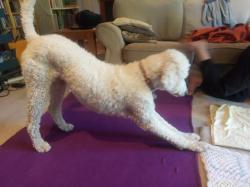What is Somatic Movement - and how can it support us?
Learning to look after ourselves is a part of life that becomes even more important as we get older. That isn’t always easy to hear - many of us live full lives (often with others to take care of as well), and we often end up with little time and energy for taking care of our own needs.
But we can find little windows to turn towards ourselves in everyday life - even things as small as taking a pause and a breath, savouring that first sip of tea, or sitting down for a few minutes even when the washing is piling up - these things can bring so much more space into our busy lives.

Somatic Movement is an amazing practice that I am so glad I have worked to make space for in my life. If you too live with pain, are finding your movement is more restricted, struggle to notice when your emotions are rising, or often find yourself feeling stressed and crabby, Somatic Movement can help.
What is Somatics?
Somatic Movement, often just referred to as ‘Somatics’, is a gentle modality, originally developed by Thomas Hanna, which retrains your nervous system to relieve muscle tension caused by trauma, stress, injury or habits. It is a slow, gentle, conscious form of physical movement, based on developmental movements, and is suitable for all abilities. It is a wonderful way to become more aware of your internal sensations, which is essential for learning new patterns - and getting out of old ones.
Somatic Movement uses the technique of pandiculation to retrain our nervous system and allow our muscles to release the chronic tension they carry. Think about a dog or cat when it first gets up from a nap: it will always do a big stretch, often first moving slowly into a deep ‘tummy dip’ - curving its back right down so that its tummy almost touches the floor - before rounding its back luxuriously in the most amazing rainbow-shaped curve.

This action, of moving into a gentle, slow contraction, before slowly releasing those muscles, allows our nervous system to ‘remember’ that ‘this is what it feels like to contract this set of muscles - and this is what full release of those muscles feels like’. And doing this consciously, with different muscle groups, is the basis for the approach of Somatic Movement: we work to become increasingly aware of our movements, and the contraction and release of our muscles, through practising specific body movements, to pandiculate muscles and integrate new patterns. And this allows our nervous system to learn to release the chronic muscle tension which many of us carry.
Who could benefit from this approach?
Anyone who experiences chronic pain, postural issues, or difficulties with sensing their internal sensations, may find Somatics helpful. It is also a beautifully relaxing practice in the moment (I’ve not known anyone yet to not come to the end of a session feeling more relaxed!) - as well as, over the long term, supporting the nervous system to release the stress-causing tensions we carry. Finally, Somatics is an extremely helpful foundation for any sort of movement practice or sport that you might enjoy, where moving freely, comfortably and safely is important. It has certainly helped me in my strength training, dancing, and rock climbing hobbies - and even in doing my crochet!
Why does it work?
The physical movements we repeat regularly are stored in our brain, which helps us to be efficient in our movements. Due to our activities (day-to-day tasks, work, hobbies such as sports or playing a musical instrument, and so on), we develop certain patterns of movement and lose our conscious awareness of what our muscles are doing in those movements. This is what we know as ‘muscle memory’ - the ability to enact a certain posture or movement without any conscious thought about what the muscles are doing.
And it’s very helpful! Imagine if you had to think hard about how to clean your teeth, brush your hair or even just pick up your cup of tea each day - everything would take a very long time, and you would make lots of mistakes! If you want to get an idea of what it would feel like to lose your ‘muscle memory’, just try cleaning your teeth with your non-dominant hand and notice how aware you have to be to do it. (Even if you are ambidextrous, you will likely have preferred hands for different activities - so find an activity where you have a preference and make a switch and see what it’s like!)

As well as habitual movements and postures, injuries can cause our muscles to tighten up around the site of the pain/injury, in order to protect us as we heal. This is very helpful in the short term, but these tightenings can continue long after the original injury has healed, as they have become ingrained as a habit (i.e. our nervous system has ‘forgotten’ how to do things differently - how to fully release the muscle contractions). Again, we need to regain conscious control of our muscles to retrain them. Stress and emotional trauma are similarly held in the body, and also need addressing through conscious awareness of our muscular tensions and patterns of posture and movement.
What happens in a Somatic Movement session?
You will need to wear comfortable, stretchy clothing (jogging bottoms/leggings, t-shirt, etc) if possible, which will allow you to move freely. The exercises are not strenuous in the usual sense of ‘exercise’, and although you need a bit of floor space and (occasionally!) a chair, there is no special equipment that you need to have.
Your teacher will guide you in the principles of the approach, and teach you specific self-care movements to support you in gaining awareness and control of your muscles. The aim is for you, the student, to take ownership of the process, to empower you to continue to make gains and overcome issues throughout your life.
How long will it take for me to see improvements?
There’s no easy answer to this. It will depend on factors like: how long you’ve been carrying the chronic muscle tension; whether you are engaging in habitual movement currently that reinforces any issues you have; and your patterns of tension throughout the body. Along with whether you engage regularly with the practice or not, of course!
There is no magic wand for this work. But with regular practice, and through increasing your knowledge and understanding of, and skill in using the approach, you may see significant gains within a few months. The most important thing is to do the exercises slowly, consciously and frequently (daily is ideal). Over time you will start to find yourself bringing the principles into your everyday life, and this helps to bring even more shifts in the issues you are experiencing.
How to get started
I have a number of offerings for you to explore, to get you started with Somatics. Please feel free to get in touch if you can’t find what you’re looking for, or if you have any questions at all.
If you aren’t at all familiar with Somatics, and just want to get a taste of what it can bring you, you might want to start with my one-off, pre-recorded session, Introduction to Somatics.
If you want to dig deeper, you can find pre-recorded, themed Somatic Movement courses, covering areas such as stress relief, relieving back pain, and improving breathing, amongst others. These short courses are suitable for beginners to the approach, or for anyone wanting to go a bit deeper into a specific area of their practice.
If you’d prefer to attend live classes (either online or in person, RG40), you can join the membership. I assume no knowledge of Somatic Movement from the start of new themed blocks, and you can find our next start dates here.
If you just can’t wait for the next themed block of live classes, you can’t lie on your back, or you have very specific or complex issues that you wish to work on, please just get in touch to find out about 1:1 sessions.
You can find more details about all of my Somatics offerings here, or sign up to our newsletter to be notified of upcoming courses and events, as well as learning more about Somatic Movement. Or you are welcome to get in touch if you want to find out more or ask any questions.
I look forward to connecting with you in this beautiful practice!
Emilie
Testimonials
“Thank you so much Emilie, I loved it! I never expected to feel so relaxed afterwards. I really enjoyed listening to your recording last night to practice. I’m loving how much concentration and focus it needs to I work out how to do the pandiculation. It’s enough to engage my mind so I’m not away with thinking/worrying and the combination of this and the deep connection with the body seem to allow my system to relax which is really rare. I’m excited to see the effect of the practice on pain and flexibility too.”
“This week I noticed a new internal sensation when I get angry (I feel a tight band of muscles constrict around my upper chest, under my arms). I was quite surprised to feel it! This is great because I can make a mental note to watch for that sensation as a trigger that it’s time to be more intentionally mindful and step away if needed.”
“Thank you Emilie, it’s just been a real revelation, and such a door opening on a whole new sort of physical, mental healing opportunity, so I’m so grateful, just thanks so so much, it’s been brilliant.”
“I’ve really enjoyed connecting with you all and I feel a lot of optimism about the power of CS [Clinical Somatics] to help with ongoing pain and also with my work around calming my nervous system! Thank you for your work in bringing this information to the world.”
“I think your descriptions are so clear - that’s what I’m impressed by, I don’t have to look at you or see what you’re doing, it’s so easy to follow you.”
“You have obviously put so much thought and effort into the course and it really paid off, I felt in very safe hands. I’ve learnt so much, in such a short space of time, but I never felt hurried. Thanks again, it was a great experience.”
“I’ve really noticed a difference, like just that Standing Awareness, and how I might use it in normal things I’m doing - I realise I am checking with my body more. And that’s one of the things I really wanted to get from this, that’s great - even if it’s just a small step forward it feels really positive.”
“I went into the course feeling hopeful. I trust Emilie’s opinion and value her expertise and experience. I wasn’t disappointed! Although life has gotten in the way of me really using the Clinical Somatics exercises regularly, I still felt a huge shift in various ways as a result of participating in the class. I probably only practiced 8 times in 6 weeks. Each time I felt centred, grounded and more connected in to my own feelings and experience. My awareness of my body has really developed. Particularly my awareness of my posture, which is slowly improving. I’ve also found that I’m more able to notice sensations that might be a hint for me to step back from hard situations right at that moment - which has been very helpful! Emilie is a great facilitator, very knowledgeable and trauma informed, with a real focus on participants honouring our own needs and experience. Thank you Emilie, I’m so glad I did the course and I look forward to getting a regular practice going soon and reaping the benefits :) "
“I went into the course feeling hopeful. I trust Emilie’s opinion and value her expertise and experience. I wasn’t disappointed! Although life has gotten in the way of me really using the Clinical Somatics exercises regularly, I still felt a huge shift in various ways as a result of participating in the class. I probably only practiced 8 times in 6 weeks. Each time I felt centred, grounded and more connected in to my own feelings and experience. My awareness of my body has really developed. Particularly my awareness of my posture, which is slowly improving. I’ve also found that I’m more able to notice sensations that might be a hint for me to step back from hard situations right at that moment - which has been very helpful! Emilie is a great facilitator, very knowledgeable and trauma informed, with a real focus on participants honouring our own needs and experience. Thank you Emilie, I’m so glad I did the course and I look forward to getting a regular practice going soon and reaping the benefits :) "
“Thank you so much for these past 6 weeks or so. I found the classes to be exactly what I needed to make me stop and take the time to tune in to my body. The exercises seem simple yet there is so much to them and I appreciate the awareness I have been developing to the nuances of the way my body moves. It is like making friends with a stranger, a stranger I often perceive as scary… yet she’s not! I can feel the difference this is making to being able to connect with myself. It’s hard to put into words. You are an awesome instructor/facilitator. I always felt like no question was a stupid question and I felt really safe in your hands. I have been recommending you and will continue to do so. I feel like your classes are a beautiful entry point for parents who are disconnected from themselves and resistant to body awareness.
Love that you’re doing this!”
About Emilie
I am certified to deliver Somatic Movement education classes, in the tradition of Thomas Hanna. I am a Somatic Movement Center® Certified Exercise Instructor (level 3) (through Sarah Warren’s Somatic Movement Center training), and a certified Essential Somatics Movement Teacher (through Martha Peterson’s Essential Somatics training).
Emilie Leeks
AuthorEmilie is a heart-centred life mentor and space holder, supporting those on a healing path. This is not an easy journey, and often we can find ourselves losing our way. Emilie's work meets you where you're at, with beautiful, accepting support and connection, and weaves that support with practices and explorations in self-compassion, body connection, and a return to a deep trust in ourselves. Note: all blog post content which refers to them, has been read and agreed to by Emilie's children.
View All Posts